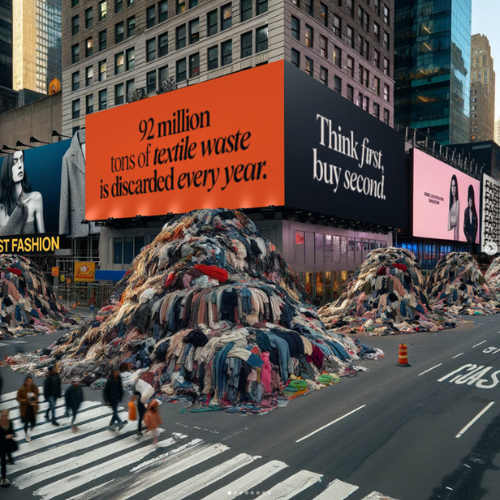In a significant stride towards sustainability, Vestiaire Collective, a leading secondhand luxury platform, recently announced its second wave of removing and banning fast fashion brands from its platform. The platform started this initiative in 2022 after some employees visited Kantamanto, Ghana.
Kantamanto, recognized as the largest reuse and upcycling economy in the world, witnesses a staggering flow of an estimated 15 million garments through its market every week. Confronted with the extremities of this, Vestiaire Collective decided that it did not want to be part of this industry and its environmental and social impact.
To effectively identify and exclude fast fashion brands, the platform developed a framework grounded in five criteria contributing to the overconsumption culture. These criteria include the following: a low price point and the repairability of the garment, an intense renewal rate based on the estimated number of new items dropped per year, the wide product range and the number of available items at any moment, the speed to market and the frequency and intensity of sale promotions.
By banning fast fashion brands from its platform, Vestiaire Collective aims to encourage consumers to be more sustainable. Looking ahead to 2024, the platform has further committed to this effort by implementing additional steps to remove fast fashion from its marketplace.
However, Vestiaire Collective is just one marketplace in the realm of secondhand platforms. This prompts some crucial questions: should all secondhand platforms follow suit and remove fast fashion brands? And for consumers: is it okay to buy fast fashion second-hand?
These questions frequently arise, especially knowing the environmental and ethical implications associated with the fast fashion industry.
So, let’s look at my take on this topic.
The Differences Between Second-Hand Platforms
Vestiaire Collectives’ primary focus is luxury and has always been luxury fashion. Therefore, its decision to exclude fast fashion aligns with its company identity and mission. The platform is aimed at consumers who wish to buy luxury items associated with craftsmanship and durability. The ban on fast fashion brands ensures that Vestiaire Collective maintains its commitment to its consumers by only providing high-quality, exclusive designer products.
The argument against selling fast fashion on luxury platforms may be a perfect fit for Vestiaire Collective. Still, it is essential to recognize that second-hand platforms serve diverse audiences with distinct interests.
Consider Vinted, for example, a platform with a broad spectrum of consumers who aren’t necessarily looking for designer items. Instead, Vinted consumers seek affordable clothing options to complement their wardrobes.
Vinted’s marketplace thrives on a diverse audience that appreciates the affordability and accessibility of second-hand clothing. Unlike Vestiaire’s luxury-centric approach, Vinted caters to individuals looking for budget-friendly fashion choices. Imposing a ban on fast fashion might not align with the needs of Vinted’s market, where users actively seek economical and stylish wardrobe updates.
To answer the first question, “Should all secondhand platforms follow suit and remove fast fashion brands?”. No, they should not if it does not align with their commitment and target audience.
The Problem With Fast Fashion
There are many arguments against buying fast fashion in general. The quality is low, it is not durable, it has a huge environmental impact, not ethical, and so many more. And this honestly does not change if you buy the item second-hand.
However, the heart of the issue with fast fashion lies in the overconsumption and the disposable nature of the garment.
Overconsumption
Fast fashion operates on an accelerated production schedule, releasing new collections at an extreme pace. This constant influx of new styles encourages consumers to update their wardrobes to keep up with the latest trends. In addition, brands prioritize low prices to make the items affordable for a big audience, which prompts individuals to buy more than they need or use (Let’s be honest, we all have bought an item because it was so cheap only never to wear it).
Disposable Nature
To keep the costs low and meet the demand of the low turnover, fast fashion brands use low-quality materials in production. This results in clothing not built to withstand extended wear or multiple washes.
Moreover, fast fashion heavily relies on constantly changing fashion trends. As trends evolve, older styles become outdated, contributing to a culture where clothing is discarded not because it is worn out but because it is perceived as no longer fashionable. This concept aligns with the idea of planned obsolescence, where products are intentionally designed to have a limited lifespan to encourage frequent replacements. For some items, the life cycle can be as short as 35 days.
The Case for Second-Hand Fast Fashion
Given the insights into the environmental and ethical challenges of fast fashion, what could be the case for considering second-hand fast fashion?
Opting to buy second-hand items aligns with sustainability goals by promoting the reuse and recycling of existing products. This conscious choice directly contributes to a reduction in the demand for new production, which is known for its resource-intensive processes and significant environmental and ethical impacts. Additionally, the decision to buy second-hand extends the lifespan of these items, preventing them from ending up in landfills.
Choosing second-hand fast fashion, therefore, emerges as a mindful and environmentally friendly alternative. It allows individuals to make conscious decisions that not only align with sustainability goals but also offer the opportunity to discover stylish clothing at a more affordable price compared to new items. This approach breathes new life into pre-loved garments, emphasizing the value of reuse and reducing the overall environmental footprint of the fashion industry.
To answer the second question, “Is it okay to buy fast fashion second-hand?”. Yes.
Conclusion
While applauding Vestiaire Collectives’ move to ban fast fashion brands from their platform, such a ban should not be applied to all second-hand marketplaces.
Ideally, the most sustainable scenario would be the absence of fast fashion brands altogether, replaced by ethical and conscious fashion alternatives. However, acknowledging the current reality, where fast fashion is prevalent and easily accessible, the next best choice is opting for second-hand purchases if you genuinely appreciate a particular product. In a world saturated with fast fashion, making the conscious decision to buy these items second-hand becomes a practical step toward promoting sustainability and reducing the environmental impact of the fashion industry.
Sources
All pictures contain a link to their source, and all credits go to the rightful owners.
You can find the link to the header picture HERE






